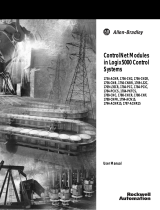
Table of Contentsii
Mapping
Data into the Image T
able 2-4. . . . . . . . . . . . . . . . . . . . . . .
16point Discrete Input Module (1794IB16) Image Table Mapping 2-5
Memory Map of 16Point Discrete Input Module
Image T
able - 1794IB16 2-5. . . . . . . . . . . . . . . . . . . . . . . .
Input Delay Times for the 1794IB16 Input Module 2-5
. . . . . . . . .
16point Discrete Output Module (1794OB16) Image
Table Mapping 2-6
. . . . . . . . . . . . . . . . . . . . . . . . . . . . . . . . .
Memory Map of 16Point Discrete Output Module Image
Table - 1794OB16 2-6. . . . . . . . . . . . . . . . . . . . . . . . . . . .
16point
Discrete Input/Output Module Image T
able Mapping -
1794IB10XOB6 2-6
. . . . . . . . . . . . . . . . . . . . . . . . . . . . . . . .
Memory
Map of 16Point Discrete Input/Output Module
Image T
able - 1794IB10XOB6 2-6. . . . . . . . . . . . . . . . . . .
8point Discrete Electronically Fused Output Module
(1794OB8EP) Image Table Mapping 2-7. . . . . . . . . . . . . . . . .
Memory Map of 8Point Discrete Electronically Fused
Output Module Image T
able - 1794OB8EP 2-7. . . . . . . . . .
8point Discrete Sensor Input Module (1794IB8S) Image
Table Mapping 2-8
. . . . . . . . . . . . . . . . . . . . . . . . . . . . . . . . .
Memory Map of 8Point Discrete Sensor Input Module
Image T
able - 1794IB8S 2-8. . . . . . . . . . . . . . . . . . . . . . .
Input Delay Times for the 1794IB8S Input Module 2-8
. . . . . . . .
8point Discrete Input Module (1794IA8) Image Table Mapping 2-9
.
Memory Map of 8point Discrete Input Module Image
Table - 1794IA8 2-9
. . . . . . . . . . . . . . . . . . . . . . . . . . . . . .
Input Delay Times for the 1794IA8 Input Module 2-9
. . . . . . . . .
8point Discrete Output Module (1794OA8) Image Table Mapping 2-10
Memory Map of 8point Discrete Output Module Image
Table - 1794OA8 2-10
. . . . . . . . . . . . . . . . . . . . . . . . . . . . .
8point Discrete Relay Output Module (1794OW8) Image
Table Mapping 2-10
. . . . . . . . . . . . . . . . . . . . . . . . . . . . . . . . .
Memory Map of 8Point Discrete Relay Output Image Table -
1794OW8 2-10. . . . . . . . . . . . . . . . . . . . . . . . . . . . . . . . . .
8 Input Analog Module (Cat. No. 1794IE8) Image Table Mapping 2-11
Memory Map of Analog Input Module Image Table - 1794IE8 2-11
Range Selection Bits for the 1794IE8 Analog Input Module 2-12. .
Word/Bit Descriptions for the 1794IE8 Analog Input
Module Write 2-12. . . . . . . . . . . . . . . . . . . . . . . . . . . . . . . .
4 Output Analog Module (1794OE4) Image Table Mapping 2-13
. . . .
Memory
Map of Analog Output Module Image
Table - 1794OE4 2-14. . . . . . . . . . . . . . . . . . . . . . . . . . . . .
Range Selection Bits for the 1794OE4 Analog Output
Module (Write Word 6) 2-14
. . . . . . . . . . . . . . . . . . . . . . . . .
Word/Bit Descriptions for the 1794OE4 Analog Output Module 2-14
Analog Combo Module (1794IE4XOE2) Image Table Mapping 2-16.
Memory Map of Analog Combo Module Image
Table - 1794IE4XOE2 2-16. . . . . . . . . . . . . . . . . . . . . . . . .


























